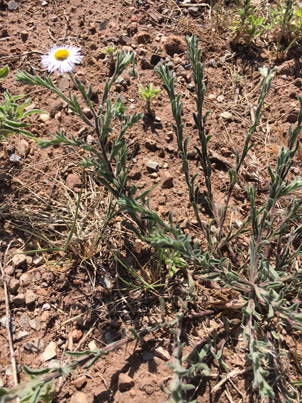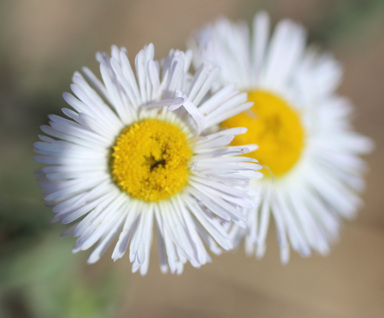
Location
By church (35D33'06.468 X W105D41'21.948)
Flowers first observed: 6/7/17
Plant w/Flower

The Flower

Distribution
"Flowering May-Jul(-Aug). Dry hills, grasslands, often in gravelly or shaley soil, sagebrush, pinyon-juniper, pine-oak, oak; 1700-2700 m; Ariz., Colo., Kans., Nebr., N.Mex., Okla., S.Dak., Utah, Wyo.; Mexico (Chihuahua)." (SEINet)
Description
"Perennials, 5-35 cm; taprooted, caudex branches relatively thick, usually retaining old leaf bases. Stems erect, densely white strigoso-canescent, eglandular. Leaves mostly basal (persistent , ± erect; leaf bases broadened or not, not thickened and whitish-indurate); blades linear-oblanceolate to oblanceolate, 20-100 × 2-5(-7) mm, cauline sharply reduced or 0 (restricted to proximal 1 / 4 - 1 / 2 ), margins entire , faces densely white strigoso-canescent, eglandular. Heads1(-4). Involucres 5-7 × 9-16 mm. Phyllaries in 3-4 series, densely hirsute to strigoso-hirsute, minutely glandular. Ray florets 20-50(-70); corollas white to light blue, 7-12 mm, laminae reflexing, sometimes tardily. Disc corollas 3.7-5.6 mm. Cypselae (nearly terete,) 2.8-3.5 mm, (8-)10-14-nerved, faces glabrous; pappi: outer of setae or bristles, inner of 24-36 bristles. 2n = 18." (SEINet)
Ethnobotanical Uses
Medicine:
"Navajo, Ramah Ceremonial Medicine Plant used in ceremonial chant lotion. Disinfectant Plant used for 'deer infection'." (Moerman 218)
Internet Links